If you go down in the Sugar Maple Woods Today, Be Prepared for a Big Surprise. You'll Find An Authentic Sugar Shack in Full Swing.
There are but a few things that come to the top of your mind as soon as you think about the country of Canada.
They are:
- winter, that seems to last forever;
- the game of hockey;
- and maple leaves.
It seems that you can't travel too far down any given road in Canada without being reminded of these 3 things.
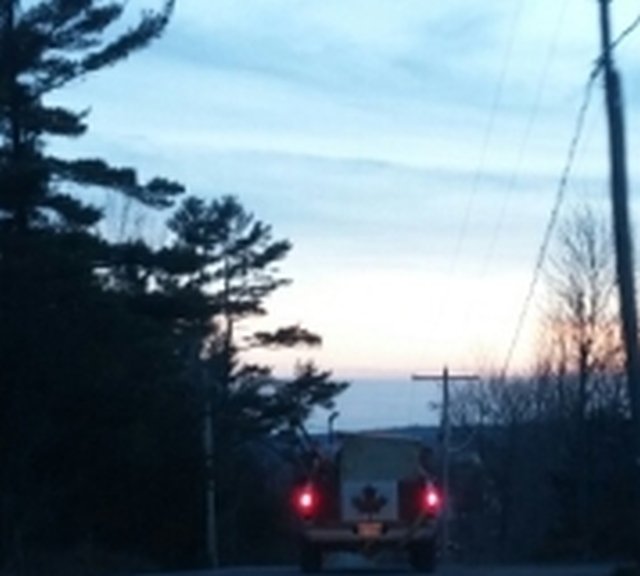
Hahaha! Seriously, I'm not joking. I took this picture last night on our way home from the sugar maple woods.
The truck's tail-gate is painted to represent our country's flag which has a red maple leaf, dead centre in the middle of it. Plus, there's a few hockey sticks and a collection of shovels sticking out of the truck's box.
Grab your rubber boots and your winter coat so that you can join me in the middle of the woods as we forage directly from a mature stand of sugar maple trees!
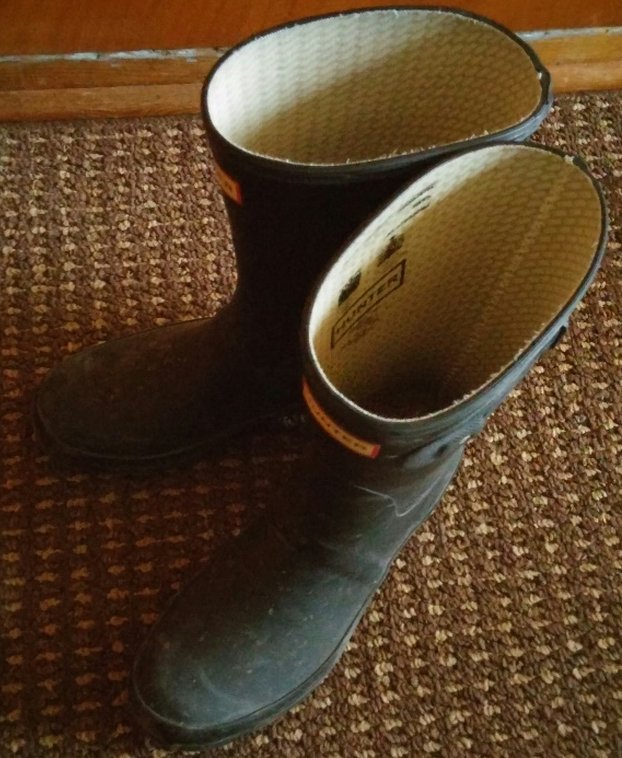
(I definitely needed mine.)
In Canada, we are currently in the middle of harvesting sugar maple sap which is called xylem sap.
It is typically foraged from sugar maple, red maple or black maple trees. These trees are all, very specific species of the maple tree, in which there are about 13 different known varieties.
At the beginning of winter, the trees produce a clear, sugary sap which gets stored in its trunk and roots. As winter slips away into the hopeful embrace of Spring, our Canadian days get warmer (above 0 degrees Celsius) while our nights still plummet below freezing.
These warm days and cold nights trigger the sugar maple trees to move the sap they have stored in their roots and lower trunks, up their tree bodies to their limbs. (This sap is used by the trees as their energy source and it is what they use to produce buds which eventually grow into their leaves in later spring and early summer.)
This process was originally discovered by the Indigenous people of North America. They were the first group of people to forage (by tapping into the trunks of the trees), harvest (by collecting the colourless sap in sealed vessels) and transform this plant material into concentrated dark syrup. They used fire and hot stones to boil the xylem sap for long periods of time until it transformed into a thicker very sticky syrup. This thick syrup is also very sweet and has a distinct maple aroma and flavour. It is the pure essence of the tree.
Today, we know that nutritionally, maple syrup is high in manganese, riboflavin, calcium, magnesium, potassium and zinc. It is one of the best natural sweeteners on our planet.
Canada produces 85% of the world's total maple syrup production which all happens in approximately 8 weeks, from mid February to mid April.
Of all the Canadian provinces, Quebec produces the most syrup and they actually have a maple syrup marketing board. Harvesters in Quebec, have quotas and maple trees are planted specifically for the purpose of producing sap. A full transport truck-size, stainless-steel tank of sap has a street value of about $1 million dollars. It's very regulated as an industry and is a multi-million dollar export business, for our country.
In Ontario, it is still legal to harvest the sap from maple trees without too much government hoop jumping if you are just harvesting for your own personal use and aren't selling your production commercially.
In my area, (which is eastern Ontario) the sap harvest started on February 18th, 2017.
@knarly327 and I were invited into a sugar maple woods, where there are 115 mature trees currently being foraged from through a process called tapping.
Here we go...
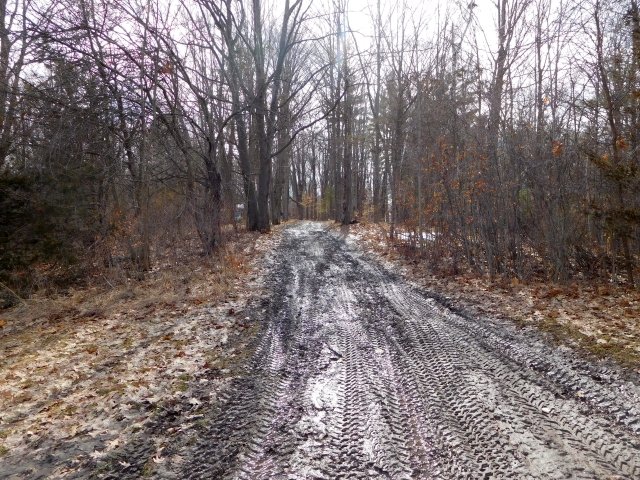
You can see how muddy it is. This is why it is advisable to wear rubber boots or old footwear that you don't mind getting dirty. There is still the odd bit of snow on the ground in patches.
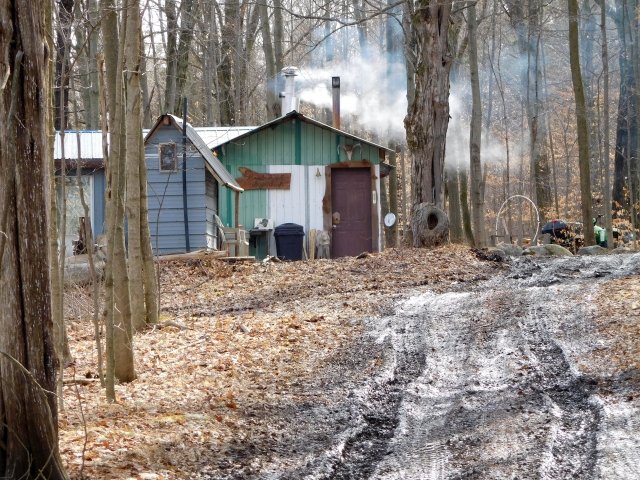
We parked our car at the side of the road and hiked approximately a 1/4 mile into the woods which was up-hill. You can see some of the sugar shack (that's what the larger outbuilding is called).
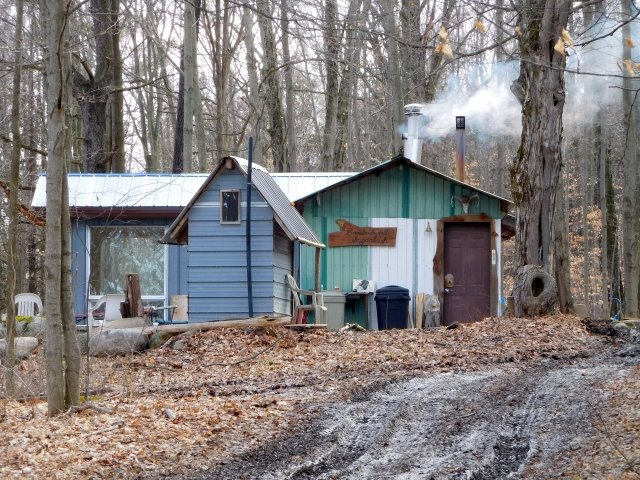
This is quite an elaborate sugar shack. The small square building with the little rectangular window and long overhang on the roof, is a very well appointed outhouse. (Nature is likely going to call, at some point, while you are in the woods.) ;)
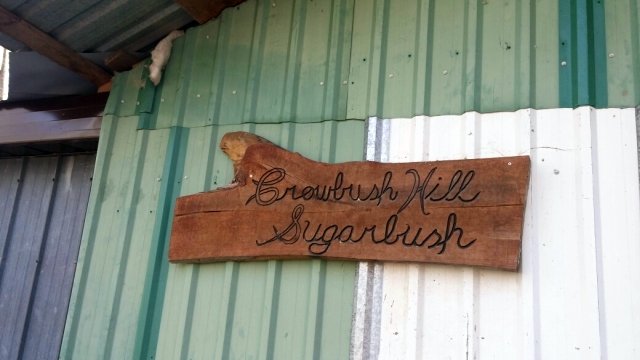
Welcome! The name of the woods and the sugar shack is "Crowbush Hill, Sugarbush". The woods and the shack are owned by a fellow whose nickname is "Crow". Apparently, this was given to him by his older brothers when he was just a young lad.
The transformation of the sap into syrup magically happens over long periods of boiling and evaporating time in the shack. (Over watchful eyes, with extreme dedication and attention to detail, I might add.)
Let's look at how the sap is harvested, shall we?
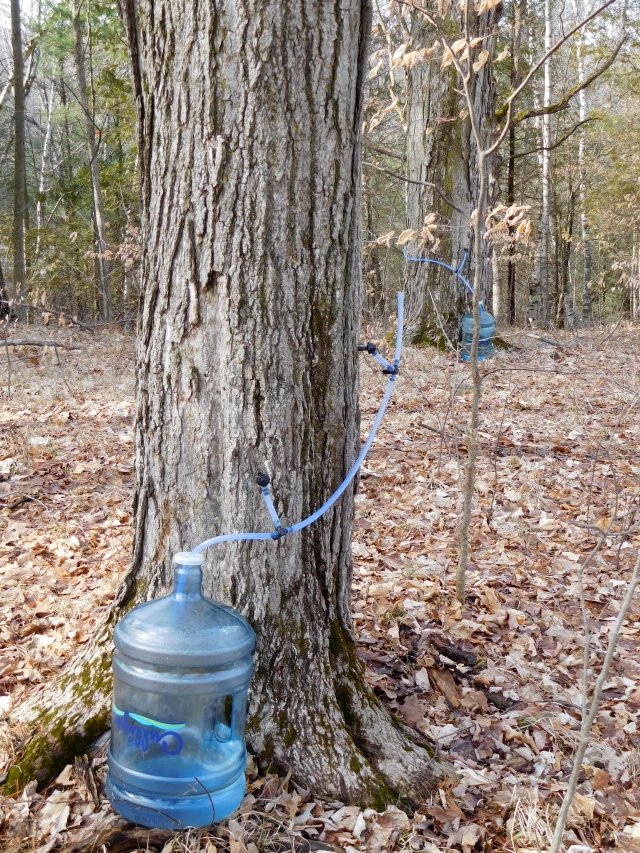
In this tree, you can see 2 taps are in place. They are feeding into plastic tubing that is then feeding into these large plastic water jugs.
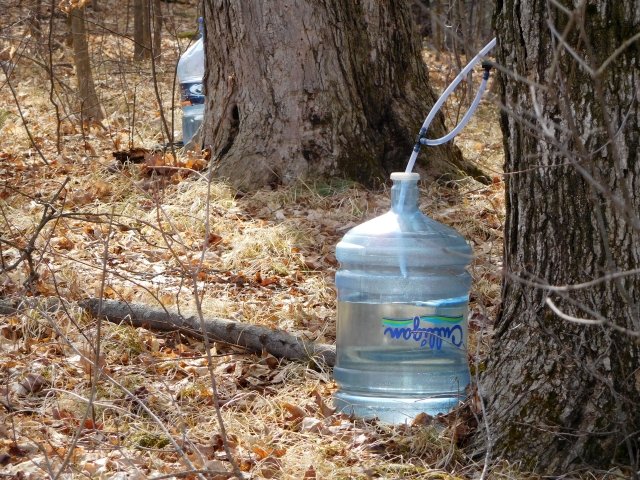
In this bucket, you can see that it is almost 3/4 full of clear sap. It is filling the bucket one drip at a time. The sap flows quickly when the temperature outside is warm during the day and cold at night. These buckets need to be emptied, every other day while harvesting is taking place.
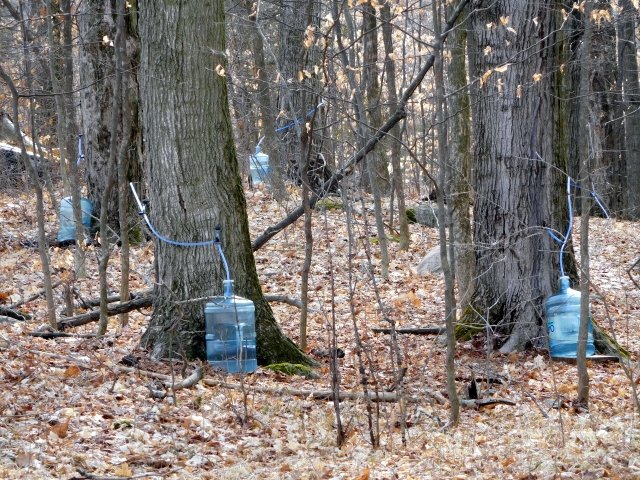
When the trees are being tapped and harvested responsibly, by people who care about the health of their maple tree forests, only 7% of the trees' total sap production will be siphoned off. This ensures that the tree will not be harmed or killed in the process. (In my opinion, the process is similar to humans donating blood. Just enough vital life force is taken to create a benefit for others.)
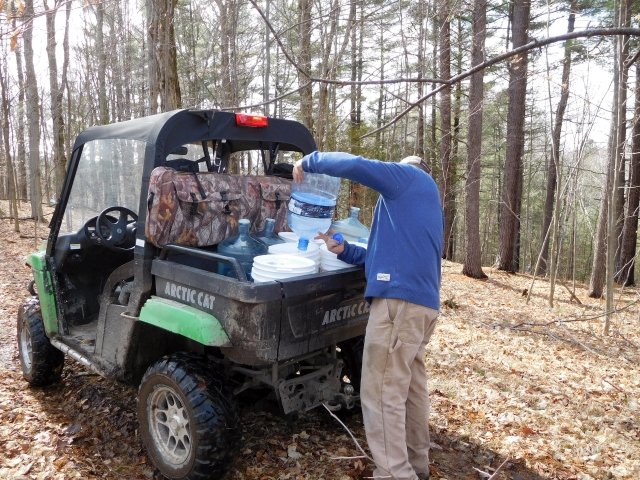
The clear jugs with their sap are then emptied into larger containers. About 55 of these jugs are collected at any one particular time.
This fluid is then emptied into a large barrel which is located just outside the sugar shack.
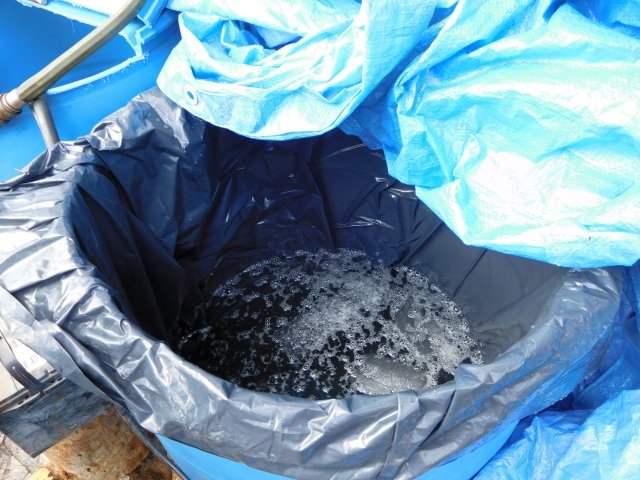
You can see some chunks of sap ice floating on the top. Just a reminder that it's only the early days of the Spring season and it's still cold outside. This barrel, feeds directly (via a pump), into the 2 stage evaporator which is wood- fired. The evaporator is located just inside one end of the shack.
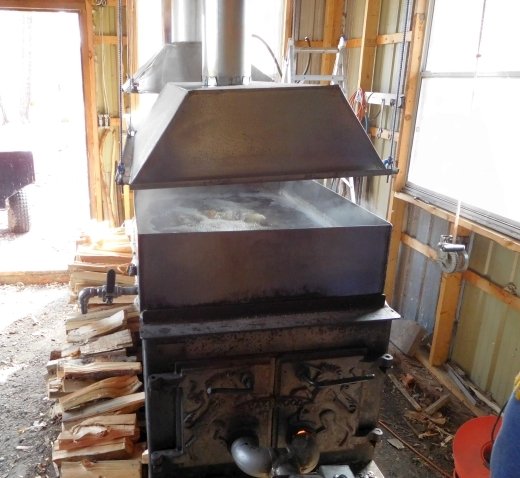
The evaporator is boiling and bubbling. Notice that the wood is cut quite small. This is to keep the fire raging quite hot for hours on end. The fire requires regular feeding every 20 minutes during the course of a whole day of syrup production.
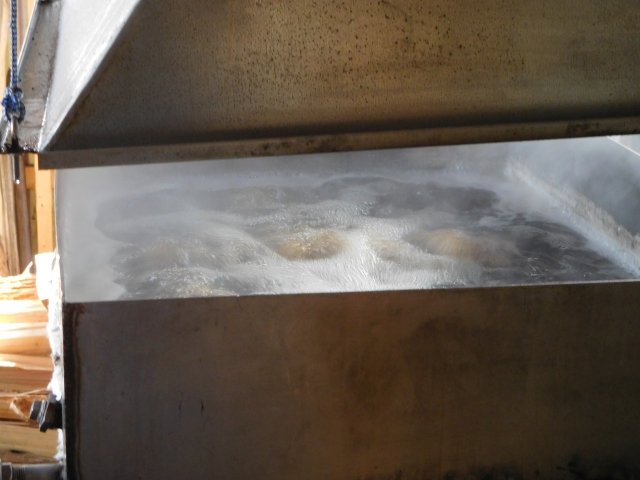
A rolling boil as the sap begins to concentrate in sugar and water is evaporated off.
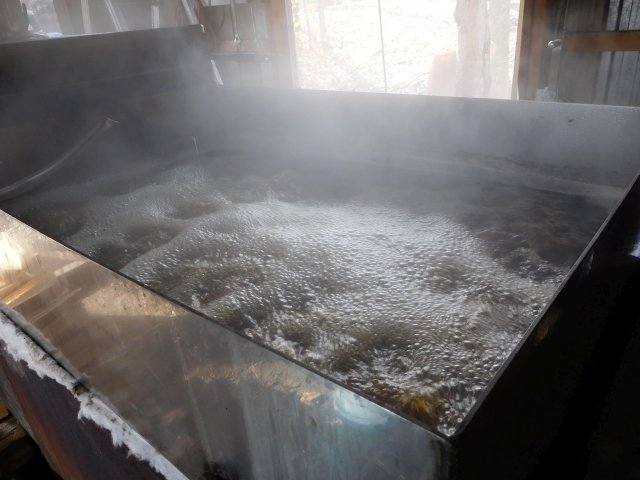
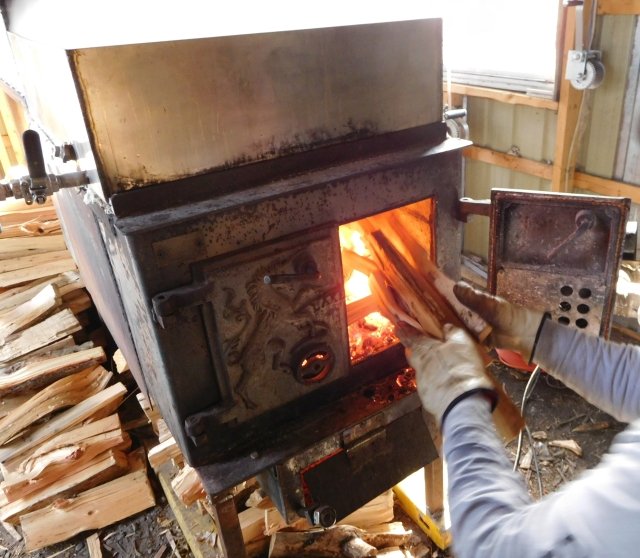
Feeding the fire is a labour of love and care.
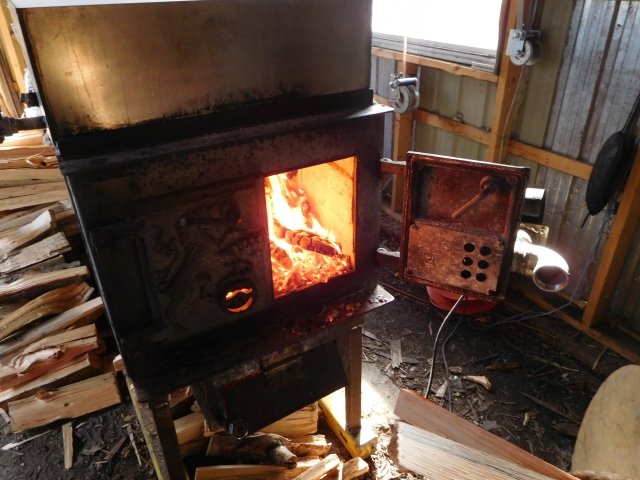
There is always orange flames.
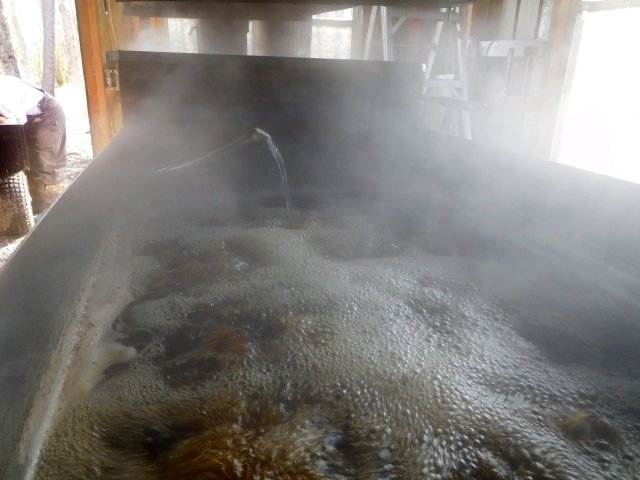
Fresh sap is being pumped into the evaporator at the far end. At this end, you can see that a colour change is starting to happen. Maple Syrup, when the correct level of concentrated sugar is achieved and the sap is siphoned from the middle of the total harvest run, is a darker brown colour.
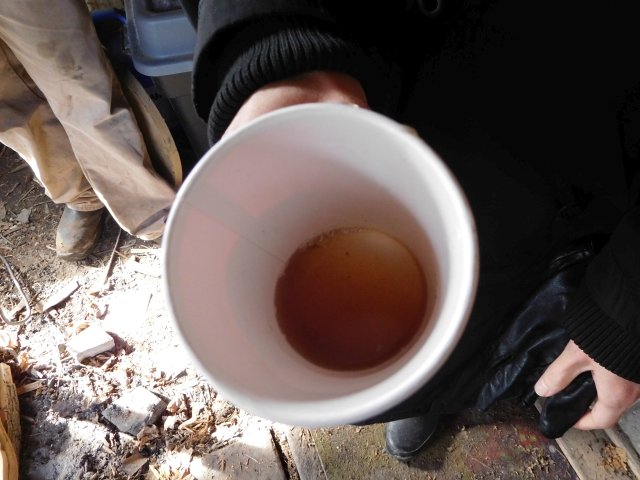
This sap is about 10% away from being finished syrup. It is still very liquid and tastes like a hot sweet tea. You have to be careful not to drink too much of it as it's one of the best natural laxatives. (You'll just have to trust me when I say it's hard to drink only a little bit of this elixir because it tastes so good. Fair warning to all, if you ever get a chance to try the syrup at this stage in its production. Go easy on it or you'll find yourself stuck in the loo.) ;)
Syrup made from the sap taken from the beginning of the run isn't as dark in colour.
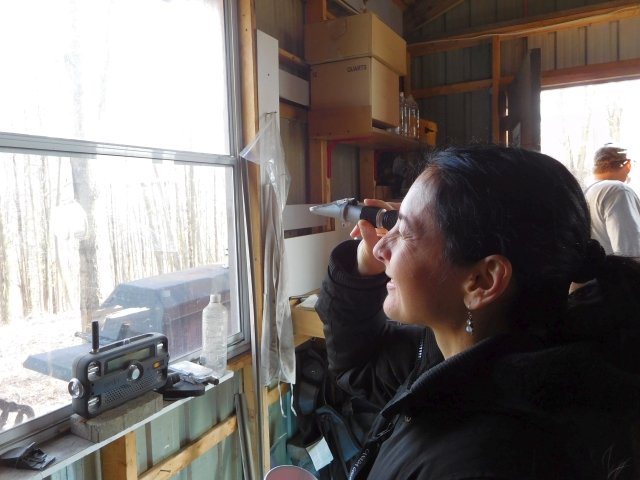
Here I am, checking the sugar content of the syrup through an apparatus called a refractometer. The sap was reading at 55. When it reaches 66, it will be considered syrup and will be ready to bottle.
This is what it looks like, in it's finished form:
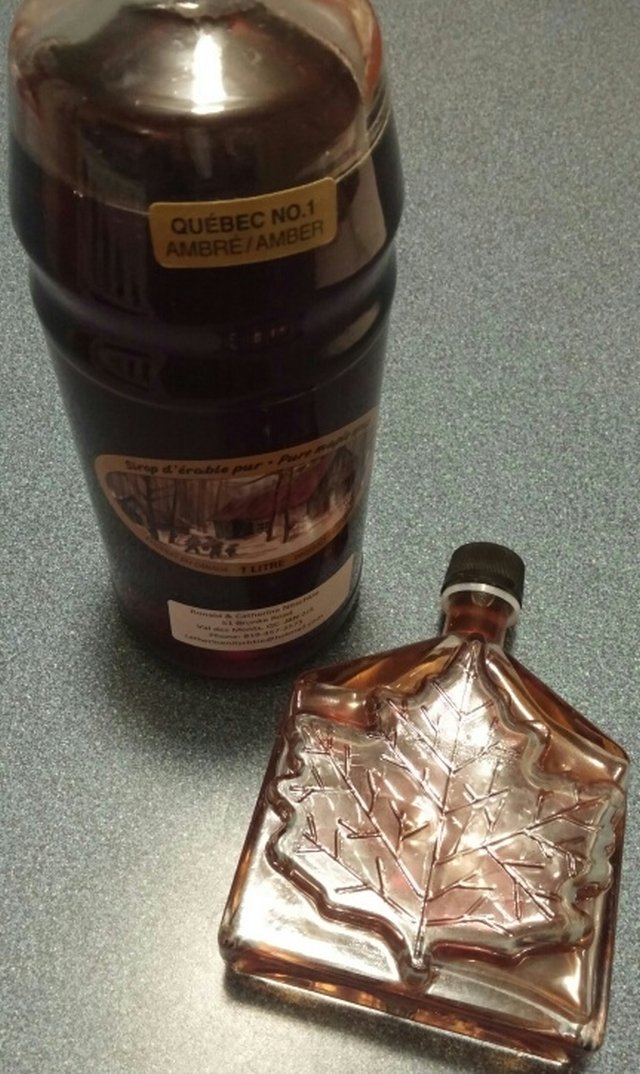
The tall cylindrical bottle is syrup from Quebec. The bottle with the maple leaf on it, is "Crowbush Hill" syrup.
In addition, maple syrup can easily be turned into candy by heating it again on a stove top or open fire. It's a fantastic treat, for young and old alike.
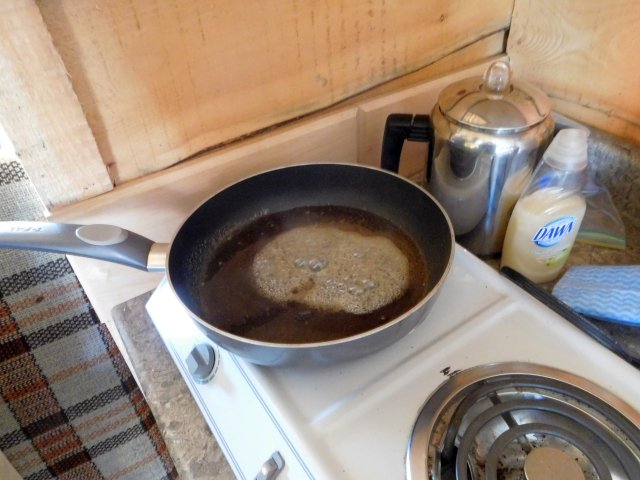
Heat the syrup to a boil, again.
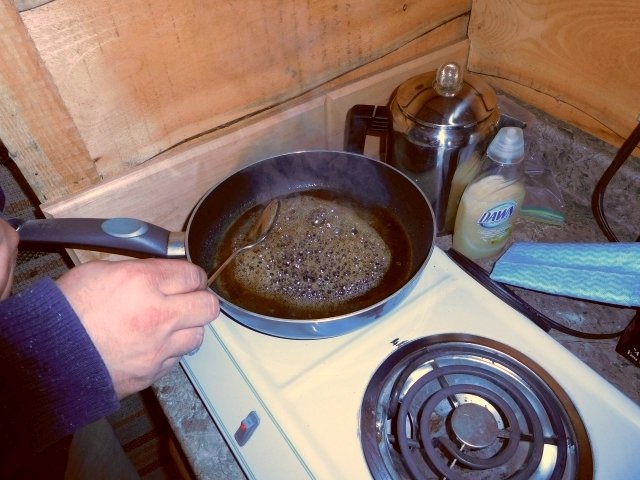
It just takes a few minutes...
Then, you spoon it right over top of clean snow! (I said clean!!! No yellow. Ever.)
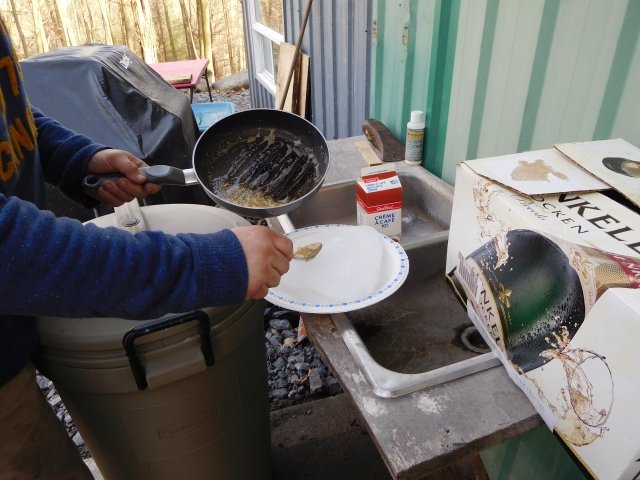
Here's the progression:
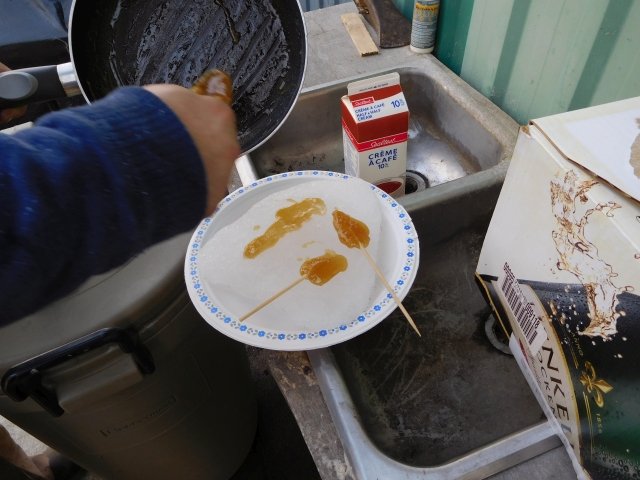
The sticks are for ease and portability.
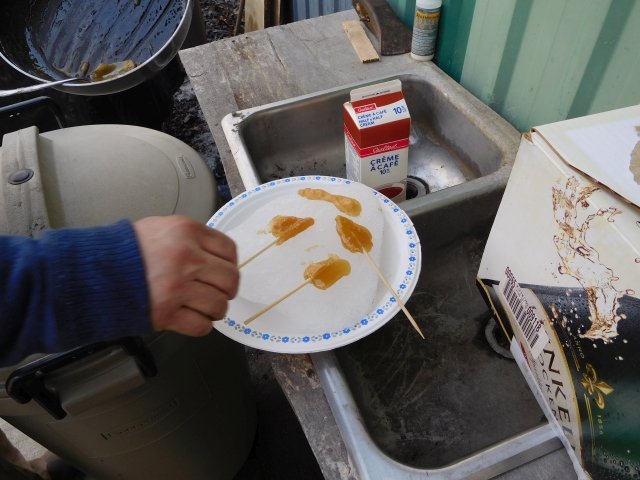
Let's see some action:
(This video was uploaded to YouTube by @knarly327 on Scrap Fe's channel.)
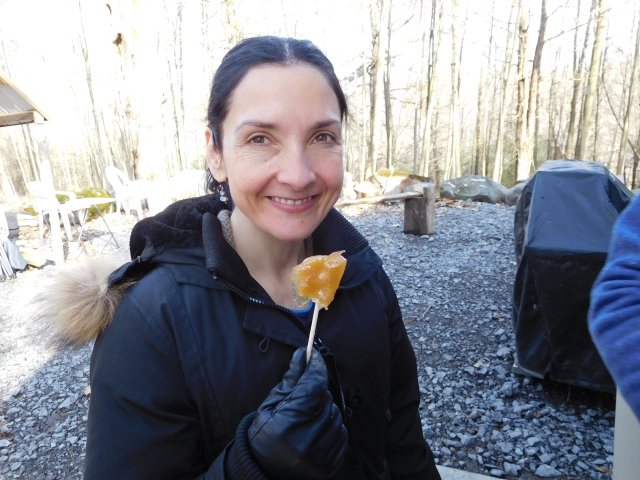
Getting to eat maple taffy on a stick is about as "Canadian" as it gets and is also a Steemit reporter perk, for sure.
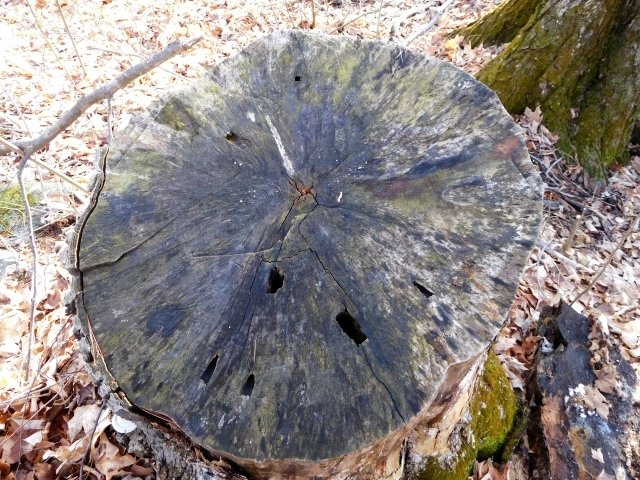
This is an old tree that had to be cut down because it split and would have landed right on top of the sugar shack.
It was approximately 150 years old and would have been one of the first original maple trees in these woods. The holes, at various intervals of history, are from original maple taps or spiles. We used original spiles which had hooks that buckets would hang off of, only about 30 years ago. This is what they looked like:
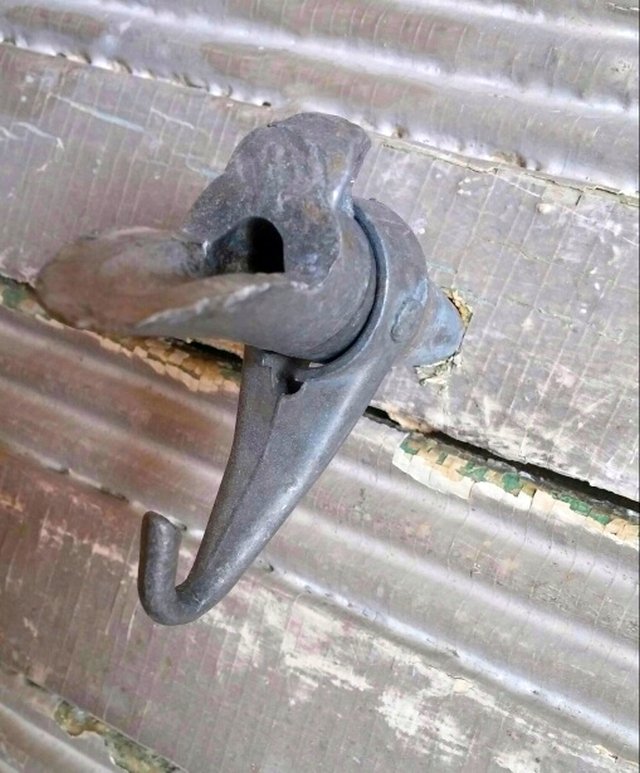
Then, we moved to plastic and hoses which accommodate larger collecting jugs or vessels and minimize the challenge of over-flowing sap pails. In large commercial productions the sap collection is even more automated. Pails and buckets no longer need to be collected by hand.
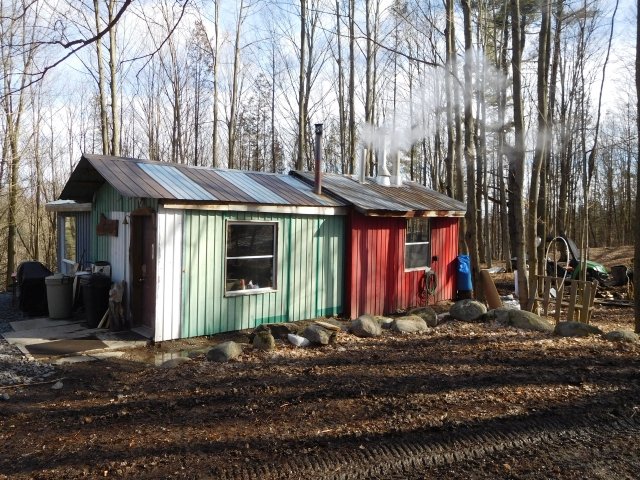
Parting is such sweet sorrow...
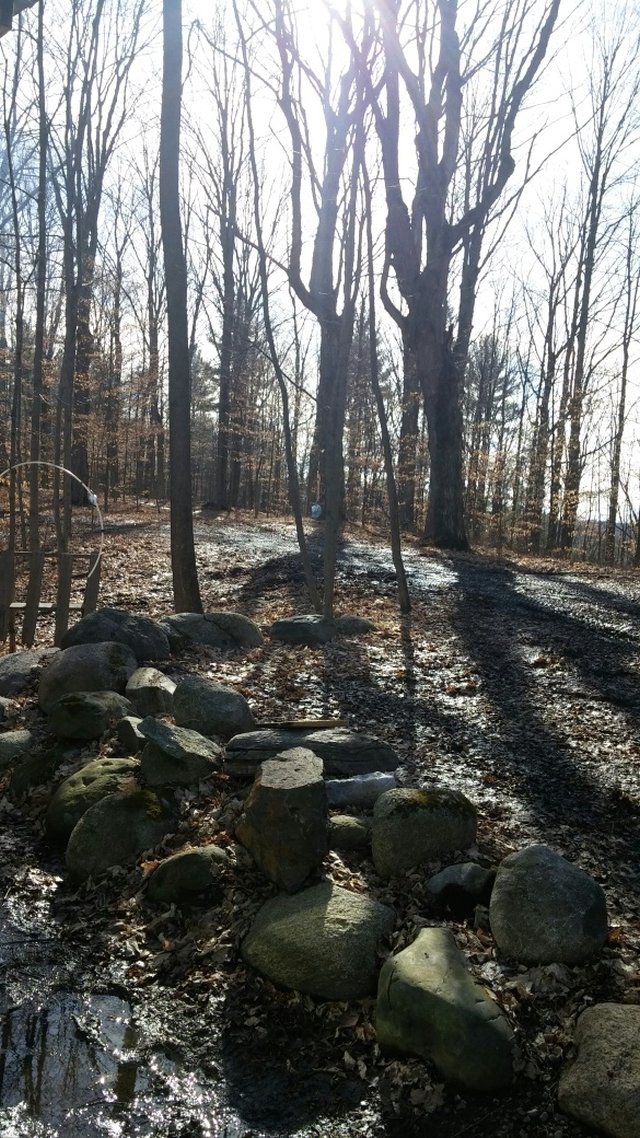
Thanks for joining me in the woods today on Crowbush Hill, Ontario Canada.
I welcome your comments and invite you to follow me on my journey.
~ Rebecca Ryan
Upvoted by @foraging-trail
Thank you for following and upvoting @foraging-trail
You can find out more about the Steemit Foraging community and guidelines for being upvoted by the @foraging-trail here and here. Join us In the Foraging-Trail and let's discuss Foraging Related Topics
Thank you!
@rebeccaryan thanks for showing us how they do it
and how to make candies.. wonder what it tastes like fresh from the tree - out of the bottle
I thought like vampires - with straws :D
Maple syrup in Canada is graded. Sap that was siphoned off at the beginning of the 8 week season is very light in maple flavour and in colour. The light syrup is what you would want to use in a recipe that you want to sweeten but that you don't want to change the visual appearance of the finished recipe...say like a salad dressing or a sauce. The darkest and the strongest maple flavour comes near the end of the season. This typically falls into a Grade B category and would be awesome to use in a recipe where it visually doesn't matter if the syrup changes the colour or you require a stronger maple flavour...say like a butter tart for example, or a maple glaze to be used over top of ham. The sap, straight out of the tree is only about 5% sugar, so it's like a slightly sweet water and it's completely clear. I think it would make an excellent sports drink. It actually reminds me of coconut water.
The way the syrup is finished reflects the flavour immensely. This particular family still fires their evaporator with wood. This gives the syrup an underlying "smokey" taste and it's what I prefer. Large operations use propane only and you don't get that earthy, I've come from the woods flavour. It doesn't "sing" IMHO.
Here in my area, people give out small bottles of syrup as their wedding favours...150 miniature bottles.
@rebeccaryan I see, I can almost imagine what it tastes like thanks a lot for the description !
You are most welcome. As you can see, we take our maple syrup quite seriously here. LOL!
Wow this was a really interesting post! First time ever I have seen how this is done.
I'm really glad you got to catch this post and liked it t@giantbear! We all just take this for granted, where I'm from and it certainly makes the effort of recording it, worth it. Thanks for commenting! I appreciate it.
Wow thats an awesome walkthrough and I love the non yellow snow candy making. Top stuff. I am a big fan of maple syrup. I suspect all the stuff we get here is twaddle compared to the likes of yours!!
There is a lot of shady practices in both the maple syrup industry and in the honey industry. I predominantly use maple syrup in my household. Honey, second and agave, a very very low third. Typically we go through about 5 litres of maple syrup a year, so we place our orders now, and keep it in our cold cellars. You just have to take your best guess and hope that you don't run dry through the year. LOL
What a great post! Must be so beautiful up there during spring and summer months. And of course the best part.... fresh maple syrup. Can't get any better than that!
Yes, I have to say that we are fortunate to have 4 unique seasons every year. Each has something different, in terms of experience to offer. Thanks for commenting.
What a great way to spend the day! It's so nice to be out in the sugarbush tapping the trees! When I lived in Michigan, I tapped sugar maples, silver maples, and even box-elder trees (a kind of maple). But only on small scale, not for a whole sugarbush. That would be special! It's an amazing process, for sure! And it's fun to hang out by the evaporator. Enjoy all that maple syrup! :D
Thanks @haphazard-hstead! I have to say that there is nothing that beats hanging around outside the evaporator room with the wind blowing in the right direction because the smell is absolutely incredible. It's even more so when real wood is used to boil the sap instead of propane. Wood gives the finished syrup a unique flavour that propane cannot produce. Yes, in differerent parts of Canada, different trees are tapped too. It's more common in the western provinces to even tap birch trees. Birch syrup is an acquired taste. I've only tasted it once, used in a reduction with balsamic vinegar. Thanks for commenting. I really appreciate it.
Wow, that's a great post! I envy how many Sugar Maples you have up there. We have them here in Iowa, too, but they aren't nearly as common. I have two beautiful specimens in my yard right by the house, and I have transplanted many more to my acreage. I have never tapped them but I think I should start doing that! I know a guy here who taps Silver Maples in addition to Sugar Maples. He says it tastes the same. Thanks for sharing!
Thanks for commenting @countryinspired! Everything you see in the post in terms of equipment and strategy is custom made by the families who are harvesting the sap from this stand of trees. They work really hard for the 8 weeks of the sap harvest. They all work full-time, so nights and weekends are taken up, but it's worth the investment. They have built, a very social sugar shack, often holding turkey and ham dinners up there for all the people who help with the process. It's magical really...but no kidding aside, a lot of work too.
That sounds awesome! A lot of hard work rewarded by good food and good company.
Exactly! Plus, great memories every time I bake with maple syrup through-out the year. ;)
Very nice educational post
Thank you @team101!
That was a GREAT post!!..I thoroughly enjoyed it!!...I can fully understand now why maple syrup us so expensive ( here in Switzerland )...tons of hard work!! Thanks again!
My pleasure @lellabird60! I'll have to send you and @kus-knee some in a can to ensure overseas survival...in all sincerity, I'm glad you liked the post.
I was "forced" to eat a lot of it in the writing of this piece. LOL!
I miss my maples.
Do maples grow in your area?
Up in Wisconsin I would tap them. I miss that.